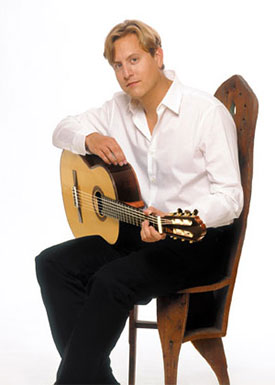Mike Telin

The program also includes Mozart’s Overture to The Marriage of Figaro and Oboe Concerto with ASO principal oboist Terry Orcutt as soloist, as well as Elgar’s Serenade for Strings and de Falla’s El amor brujo. The concert begins at 8:00 pm in the University of Akron’s E.J. Thomas Hall.
Composed in 1939, Rodrigo’s Concierto de Aranjuez is without a doubt the composer’s best-known work. “It is a popular piece and deservedly so,” Vieaux said during a recent telephone conversation. “The second movement is a masterpiece. As a guitarist, I am a little biased, but I think it’s so cool how the solo line brings the entire concerto to a climax at the end of the second movement cadenza. Rodrigo understood the guitar well enough to make sure it was at its very loudest during those ten-note flourishes.”
According to Vieaux, listeners should not draw the conclusion that just because the concerto is so popular it is an easy work to play. “It’s a fantastic piece of music but it is always challenging to perform. It’s a very difficult piece.”
What makes it difficult? “Ironically it’s the lighter-sounding outer movements that are extremely difficult to play. Rodrigo wasn’t a guitarist and it wasn’t until he started writing for Segovia that he began to write more idiomatically for the instrument. Rodrigo wrote Concierto de Aranjuez in 1939 and Regino Sainz de la Mazzo gave the premiere. But it doesn’t appear that the soloist made much of an effort to suggest some changes to Rodrigo that would make the piece a little more idiomatic. The technical passages in the first and third movements are always very challenging to any guitarist. I’ve played it about 150 times, so it has become a little easier. At the same time, you want to be at the top of your game with your scale playing in order to make sure you have a good performance. It’s just that kind of piece.”
Vieaux, who heads the Guitar Department at the Cleveland Institute and teaches at the Curtis Institute in Philadelphia, says that even with his most talented students he doesn’t recommend that they start learning the concerto until they have developed physical strength in their hands. And have had a lot of experience playing very rapid scales. “It’s not like playing fast scales in the Ponce Concerto, for example, where the scales are isolated. In this concerto you’re playing fast scales immediately after an arpeggio in the right hand, or after some tough choppy chords. The outer movements are in what I call a ‘pocket’, meaning there is not any room for rubato. The music needs to retain a very lively gait, so the guitarist needs to be on top of those shifts and the scales.”
As great as the writing in the concerto’s outer movements is, it’s still the beautiful melody in the middle movement that has captured the hearts of listeners as well as musicians of all genres — for example, Miles Davis’s 1960 album Sketches of Spain. “I’ve even read that Led Zepplin, and I’m a big fan of their albums, would include bits and pieces of the second movement in their extended improvisations during concerts. I’m certain that many audience members will recognize the second movement from movies and commercials. But there’s nothing like the experience of hearing it live and I’m looking forward to playing it with the Akron Symphony.”
A Fun Fact—the United States premiere of Concierto de Aranjuez was given by The Cleveland Orchestra on 19 November 1959 under the direction of Robert Shaw with Rey de la Torre as soloist.
Published on ClevelandClassical.com February 10, 2015.
Click here for a printable copy of this article



